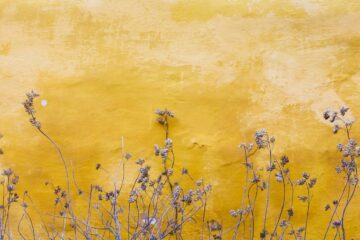HIGH DESERT GLOSSARY
(Summer Lake, Oregon)
Bleach: like bleak, blank and black, derives from the Anglo-Saxon root blac, blæc, meaning bare, after fire. Some days, especially gray days, the land glows so white it’s almost painful, like a neon light-strip in the distance.
Grammar: Desert here is not just a noun but a verb. Like sky. The hills brood, stonily animate. Tufts of saltgrass, sagebrush, manzanita, rabbitbrush, iodine bush, greasewood.
Neighbors: Deep time is all around. Mount Mazama blew itself to smithereens 7,000 years ago. Its ash and frothy magma gobs are everywhere. On the far shore of this desert playa, fossil human turds were found under a rock shelter, deposited 14,300 years ago. The people had eaten roots, like the Paiutes whose ancestral lands these are.
Pastime: Here, instead of cat and mouse, there is raptor and mouse. A bald eagle plays it with a red-tailed hawk, tossing a mouse back and forth in the air.
Pedestrians: At Fort Rock, dozens of sagebrush bark sandals were found buried in ash. They’d been here 3,000 years already when Mount Mazama erupted. They’re woven like espadrilles, in a range of different sizes. This bipedal animal we are. Always walking. Always going somewhere.
Penumbra: The earth casts its own long, curved, inky shadow on the other side of the playa. Slightly humped, like a giant trashcan lid. Its sphericality can only be seen in places such as this, the flattest ones on earth. Here there is nothing to intercept the eye; the horizontal plane is all we know.
Pilgrim: Every day, a lone coyote pads the shoreline, south to north, a little after sunrise. He and his companions leave scat full of red crabapples and yellow Russian olive berries. Their fey music after dark: will-o’-the-wisps, luring us into the vanished swamp.
Playa: a body of water in the desert that’s neither a beach nor anything remotely as simple as a lake. Sometimes it’s there; sometimes it’s not. So shallow the wind plays with it, parts it at will, harries it, sweeping it hither and thither, far out of sight. Now you see it, now you don’t. Some days it’s a brown sea, matte, opaque. Other days it’s a glassy window into the earth. Some days it is ocher, some beige, some indigo, some dove-gray. Some days, mountains float doubled in it for miles, and it’s the blue of faded lavender. Some days, white dust clouds haunt it like mist.
Sky: Enormous and ever-evolving. Scored with contrails. Flotillas of fleecy clouds scudding across oceans of forget-me-not blue. Soft shirrings and shoals of gray, a herring-bone design. The undersides of veils daubed seashell-pink, rose-tangerine. A great bowl continually filled, then emptied. Brightening, dimming. Washed-out peach, fading to ink.
Wind: A raging visitor, it can keep you pinned, penned indoors, for days, sleepless, until it exhausts itself.
Window: wind’s eye.
Witness: Trees the color of bleached bones, peeled and defoliated by fire, their mutilated limbs thrust skyward like roadkill with rigor mortis. Even the charring has been mostly scoured away by wind.
Catherine Jagoe is a translator and writer. Her most recent books are Bloodroot (Settlement House, 2016), which won three poetry awards, and two bilingual volumes by Uruguayan poets: Reborn in Ink by Laura Cesarco Eglin (Word Works, 2019), and Voice & Shadow: New & Selected Poems by Luis Bravo (Lavender Ink Press, 2020). Author of numerous essays, she won a Pushcart Prize in 2016 and a citation in Best American Essays. Her website is catherinejagoe.com.

